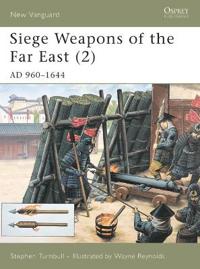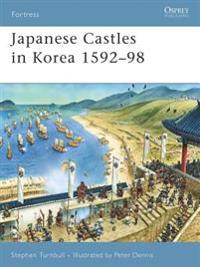Exceptional Lives (Pocket)
avAnn Turnbull, Rud Turnbull, Michael L. Wehmeyer, Karrie A. Shogren
ISBN: 9780132821773 - UTGIVEN: 2011-12-27To Do No Harm: Ensuring Patient Safety in Health Care Organizations (Häftad)
avJulianne M. Morath, RN, MS, Joanne E. Turnbull, Turnbull
ISBN: 9781118016107 - UTGIVEN: 2010-10-31Ashigaru 1467-1649 (Pocket)
avStephen Turnbull, Howard (ILT) Gerrard, Stephen Turnbull
ISBN: 9781841761497 - UTGIVEN: 2001-04The ashigaru were the foot soldiers of old Japan. Although recruited first to swell an army's numbers and paid only by loot, the samurai began to realise their worth, particularly with arquebuses and spears, until well-trained ashigaru made up a vital part of any samurai army. This book tells the st[...]
Siege Weapons of the Far East (Pocket)
avStephen Turnbull, Wayne (ILT) Reynolds, Stephen Turnbull
ISBN: 9781841763408 - UTGIVEN: 2002-01Increasingly from the 11th century AD, East Asian armies used exploding missiles and siege cannon to reduce the fortifications of their enemies. These ranged from heavy siege cannon such as those used during the sige of P'yongyang during the Japanese invasion of the late 16th century, a weapon that [...]
Japanese Castles 1540-1640 (Pocket)
avStephen Turnbull, Peter (ILT) Dennis, Stephen Turnbull
ISBN: 9781841764290 - UTGIVEN: 2003-04The most familiar characteristics of the traditional Japanese castle are the huge sloping stone walls and the graceful yet militarily sophisticated structures built on top of them. This title covers the entire period of Japanese castle development from the first introduction of stone walls and tower[...]
Samurai Commanders (2) (Pocket)
avStephen Turnbull, Richard (ILT) Hook, Stephen Turnbull
ISBN: 9781841767444 - UTGIVEN: 2005-08This second volume about Japan's samurai commanders covers the generals of the later years of the Age of the Warring States, a period when only the most able leaders survived. This was a time when the prowess of a commander was measured as much by his strategic and organizational abilities as by hi[...]
The Walls Of Constantinople Ad 324-1453 (Pocket)
avStephen R. Turnbull, Peter (ILT) Dennis, Stephen R. Turnbull
ISBN: 9781841767598 - UTGIVEN: 2004-11The walls of Constantinople are the greatest surviving example of European medieval military architecture in the world. They withstood numerous sieges until being finally overcome by the artillery of Mehmed the Conqueror in 1453, and exist today as a time capsule of Byzantine and Medieval history. T[...]
Japanese Fortified Temples And Monasteries AD 710?1062 (Pocket)
avStephen R. Turnbull, Peter (ILT) Dennis, Stephen R. Turnbull
ISBN: 9781841768267 - UTGIVEN: 2005-08From the 10th century onwards the great monastic foundations of Nara and Mount Hiei maintained large armies of warlike monks, a practice that was later followed by other institutions. The tempestuous political rivalries that developed between the different orders of monks, and even factions within t[...]
The Great Wall of China 221 BC-AD 1644 (Pocket)
avStephen Turnbull, Steve Noon, Stephen Turnbull
ISBN: 9781846030048 - UTGIVEN: 200701The most extensive and famous example of fortification in the world, the Great Wall of China stretches for more than 4,000 miles across inhospitable terrain. Charting its development from construction in the 7th century BC through to the present day, this account reveals the true history of the wall[...]
Japanese Castles in Korea 1592-98 (Pocket)
avStephen Turnbull, Peter (ILT) Dennis, Stephen Turnbull
ISBN: 9781846031045 - UTGIVEN: 2007-11The Japanese invasion and occupation of Korea, which lasted from 1592 to 1598, was the only occasion in Japanese history when samurai aggression was turned against a foreign country. During the occupation of Korea the Japanese built 25 wajo or castles. Unlike the castles built in Japan, these fortif[...]
The Samurai Invasion of Korea 1592-98 (Pocket)
avStephen Turnbull, Peter (ILT) Dennis, Stephen Turnbull
ISBN: 9781846032547 - UTGIVEN: 2008-07The invasions of Korea launched by the dictator Toyotomi Hideyoshi (1592-1593 and 1597-1598) are unique in Japanese history for being the only time that the samurai assaulted a foreign country. Hideyoshi planned to invade and conquer China, ruled at the time by the Ming dynasty, and when the Korean [...]
The Mongol Invasions of Japan 1274 and 1281 (Pocket)
avStephen R. Turnbull, Richard (ILT) Hook, Stephen R. Turnbull
ISBN: 9781846034565 - UTGIVEN: 2010-01From his seat in Xanadu, the great Mongol Emperor of China, Kubla Khan, had long plotted an invasion of Japan. However, it was only with the acquisition of Korea, that the Khan gained the maritime resources necessary for such a major amphibious operation. Written by eastern warfare expert Stephen Tu[...]
Hatamoto (Pocket)
avStephen Turnbull, Richard (ILT) Hook, Stephen Turnbull
ISBN: 9781846034787 - UTGIVEN: 2010-03Each great samurai warlord, or daimyo, had a division of troops known as the Hatamoto, 'those who stand under the flag'. The Hatamoto included the personal bodyguards, the senior generals, the standard bearers and colour-guard, the couriers, and the other samurai under the warlord's personal command[...]
First Language Use in Second and Foreign Language Learning (Pocket)
avMiles (EDT) Turnbull, Jennifer (EDT) Dailey-O'Cain, Miles (EDT) Turnbull
ISBN: 9781847691958 - UTGIVEN: 2009-09This volume offers fresh perspectives on a controversial issue in applied linguistics and language teaching by focusing on the use of the first language in communicative or immersion-type classrooms. It includes new work by both new and established scholars in educational scholarship, second languag[...]
Developing And Implementing Individualized Education Programs (Pocket)
avMargaret A. Cooper, Bonnie Baran Strickland, Ann Turnbull
ISBN: 9780131712768 - UTGIVEN: 2019-08-01Oxford Advanced Learner's Dictionary (Inbunden)
avJoanna Turnbull
ISBN: 9780194799096 - UTGIVEN: 2010-09Poetics of Gardens, The (Övrig)
avCharles W. Moore, William J. Mitchell, William Turnbull
ISBN: 9780262631532 - UTGIVEN: 1993-10-01There is a universality about the creation of gardens across time and in diverse cultures that has inspired this entirely different garden book: a playful and affectionate typology of gardens; a pattern book in which a score of landscapes and gardens are drawn, described, and analyzed not just as a [...]
The Book of Doing (Pocket)
avAllison Arden, Adam James Turnbull, Allison Arden
ISBN: 9780399537349 - UTGIVEN: 201204When did you last take the time to do the things you loved as a child: crafts, games, getting your hands dirty? Or feel the same delight and wonder that you took from your favorite childhood activities?Despite the joy we gained from these pursuits, in our adult lives, we've left them behind-they're [...]
IBS Relief: A Complete Approach to Managing Irritable Bowel Syndrome (Häftad)
avDawn Burstall, T. Michael Vallis, Geoffrey K. Turnbull
ISBN: 9780471775478 - UTGIVEN: 200608Take control of IBS so IBS doesn't take control of your life IBS Relief, Second Edition is an extensively updated, hands-on guide to help you manage your symptoms and limit the frequency, intensity, and duration of irritable bowel syndrome (IBS) episodes. Written by a doctor, a dietitian, and a psyc[...]
Samurai (Inbunden)
avStephen Turnbull
ISBN: 9780500251881 - UTGIVEN: 201202Young samurai, do you wish to obtain the martial skills to master the Way of the Warrior? The strategic know-how to lay siege to a castle? The Zenlike composure to conduct a tea ceremony? This witty, informative and unique guide to the samurai class of early modern Japan is presented in the guise of[...]
Pasta and Semolina Technology (Inbunden)
avRon Kill, K. Turnbull
ISBN: 9780632053490 - UTGIVEN: 2000-12-31Since the 1990s, the technologies employed in the production of dry pasta and semolina have changed dramatically. This practical book examines these changes and gives commercially relevant information to the reader in the areas of durum wheat, semolina production, pasta mixing and extrusion.[...]
Learning Disability Nursing (Häftad)
avEditor:John Turnbull
ISBN: 9780632064632 - UTGIVEN: 2004-01-31The Forest People (Pocket)
avColin M. Turnbull
ISBN: 9780671640996 - UTGIVEN: 198707- Colin M. Turnbull's best-selling, classic work - describes the author's experiences while living with the BaMbuti Pygmies, not as a clinical observer, but as their friend learning their customs and sharing their daily life.Turnbill conveys the lives and feelings of the BaMbuti whose existence cent[...]



























